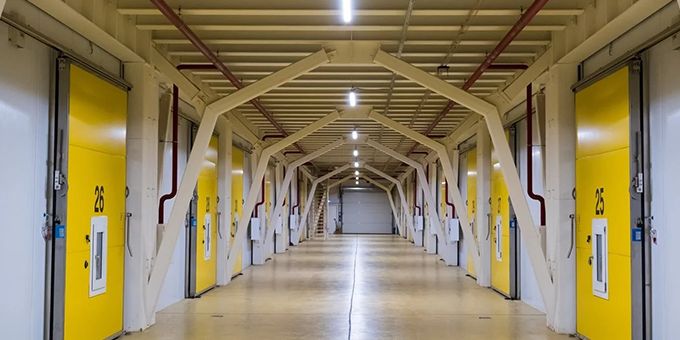Ripening of the fruit can be slowed down or accelerated by adjusting the temperature and humidity as well as by providing a targeted supply of ethylene gas and regulating the CO2 concentration.
 Ripening Fruit in Ripening Chambers – How Bananas & the Like Ripen in the Best Possible Way
Ripening Fruit in Ripening Chambers – How Bananas & the Like Ripen in the Best Possible Way

Johannes Fraundorfer | E+E Elektronik
When we buy fruit and vegetables at the supermarket, we expect them to be unblemished and ready to eat. To ensure that the fruits reach their ideal degree of ripeness exactly when they are offered for sale, many fruit and vegetable varieties are ripened in special ripening chambers after picking. To allow this to happen, the climatic conditions in the ripening chambers need to be precisely monitored and controlled. Read on to discover how fruit ripening in ripening chambers works and what is important.
Fruit Ripening and the Climacteric Phase
Natural fruit ripening begins after the fruit has completed its growth. Basically, ripening is a metabolic process in which the ingredients of a fruit change. Fundamentally, starch is converted into fructose by hydrolysis. The fruit then develops its typical taste and becomes edible. On top of this, the ripening process also changes the consistency and appearance of the fruit: bananas turn yellow, tomatoes red, avocados soft, and so on.
Only Climacteric Fruits Ripen after Picking
Fruits are generally distinguished according to whether or not they have a climacteric phase after harvesting. The climacteric phase is the stage of the metabolic process in which the harvested fruit absorbs oxygen and releases carbon dioxide through cellular respiration. Just like during ripening on the tree or plant, the starch components of the fruit are converted into sugars – the fruit ripens. At the same time, the ripening hormone ethylene (C2H4) is released; this in turn stimulates other climacteric fruits to ripen.
-
Climacteric fruits such as bananas develop their typical taste, colour and consistency in ripening chambers.
- Climacteric fruits (e.g., apples, bananas, mangoes or tomatoes) can be harvested at an early stage – after achieving minimum maturity. After harvesting, the fruits are stored in ripening chambers where they ripen to maturity for consumption.
- Non-climacteric fruits (e.g., citrus fruits, pineapples, blueberries) do not ripen after picking. They must mature on the plant before they are harvested.
Controlled Fruit Ripening in Ripening Chambers
To ensure that the fruit does not reach its ideal degree of ripeness until it reaches the supermarket shelf, it is essential to control the ripening process. This is done in ripening chambers, where the fruit is stored in the transport box on pallets or shelves under controlled conditions. Ripening of the fruit can be slowed down or accelerated by adjusting the temperature and humidity as well as by providing a targeted supply of ethylene gas and regulating the CO2 concentration.
Bananas, for example, typically reach maturity for eating within 4 to 8 days in ripening chambers. For this, they require temperatures between 14 °C and 23 °C (57,2 °F and 73,4 °F) and a high humidity of >90 % RH. To ensure that all fruits ripen evenly and there is no harmful accumulation of CO2 in the ripening chamber, a uniform air circulation and fresh air supply must also be ensured.
Technical Equipment of Ripening Chambers
To control the relevant climatic parameters and gas composition of the storage atmosphere, modern ripening chambers are equipped with the right choice of technical equipment:
- Cooling systems and humidifiers for temperature and humidity control
- Fans and ventilators for sufficient ventilation and fresh air supply
- Systems for controlling (feeding and discharging) ethylene, CO2 and nitrogen
In addition, sensors are needed to measure the humidity and temperature, the CO2 and oxygen levels, and the ethylene concentration. They form the basis for optimal control of the ripening process. The reliability and measurement accuracy of the deployed sensors therefore have a direct influence on the ripening process and on the quality of the stored fruit.
-
Ripening chambers are equipped with a variety of technical systems for monitoring and controlling the storage atmosphere.
Humidity, Temperature and CO2 Sensors for Ripening Chambers
High humidity is a particular challenge for the sensors used in ripening chambers. Permanent high humidity leads in many cases to sensor drift and inaccurate measurement results. In addition, corrosion of the sensing element and unprotected soldered joints can occur. This not only has a negative impact on measurement accuracy but also on the service life of the sensors. Since ripening chambers are cleaned between the individual ripening cycles, the sensors are also exposed to contamination by cleaning agents.
Sensors for ripening chambers therefore need to have the following properties:
- Long-term stability and high measurement accuracy, even at high humidity levels
- Resistance to dew formation, soiling and chemical contamination
- Easy maintenance (e.g., replaceable sensing probes and filter caps)
- Enclosure with a high protection class (IP65 or higher)
E+E Elektronik offers a wide range of sensors for climate monitoring. The following sensors are a great choice for reliable humidity, temperature and CO2 measurement in ripening chambers:
EE872 CO2 probe with heatable and easily replaceable sensing module
EE211 Humidity and temperature sensor for high humidity conditions >85 % RH
Discover more »
The content & opinions in this article are the author’s and do not necessarily represent the views of AgriTechTomorrow

E+E Elektronik
Lowering of energy costs, acceleration of growth and extension of the possible storekeeping duration can be optimised by the precise measurement of humidity, CO2-content and temperature. Optimum basic conditions for animals and plants ensure best agricultural products. As different applications demand various adopted solutions for optimization of agricultural processes, E+E Elektronik provides a broad portfolio of agricultural monitoring products
Other Articles
Calculating Break Even and ROI When Investing in Sensors for the Cannabis Market
"Growth Turbo" CO2 - How Does CO2 Fertilisation Work in the Greenhouse?
Cosy Climate in the Greenhouse - Climate Sensors Ensure Optimum Growing Conditions
More about E+E Elektronik
Comments (0)
This post does not have any comments. Be the first to leave a comment below.
Featured Product


